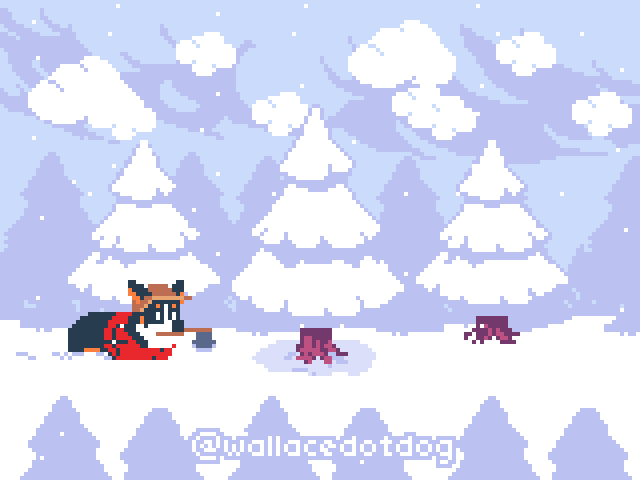I just making a small pixel animation right now, in the processing that a question just came out,
basically I don’t even know how long the animation would be up to now, maybe 2 - 3 mins, and until now, it is already 200+ frames.
So I’m curious, and I want to ask you guys, do you make animate with aseprite? I mean, animation with a plot or story board, like a real animation, no matter long or short. How many frames you made? If you want to make a real animation and have to manage 1000+ frames, how? Is it convenience?
Huge frame counts are normal for long animations like this. A minute of animation is 900 frames at 15fps, 480 at 8fps, 1440 at 24fps (in reality it’ll be a little less, as frames where nothing is moving can be represented as a single frame held for a longer time). I only really do gamedev animation, and even when animating cutscenes, I try to avoid doing this sort of storyboarded animation if I can, precisely because it’s so much work!
You can use tags to stay organized, by labelling scenes and the shots within them. Using shot tags also lets you preview that shot more easily.
If the timeline is getting unwieldy, consider splitting off each scene or even each shot (for the longer ones) into separate files. You can stitch them together later in a video editor when you do audio. If you do this though, I recommend doing your initial blocking in in the previous shot’s file before splitting it off, so you can check for weird alignments between shots before you animate too much of the new scene.
It’s currently not very convenient to manage large numbers of frames because Aseprite gives you no way to collapse tags.
For large animations with a lot of frames, Aseprite can also run out of memory, which is another reason it’s better to utilize several files and stitch the outputs together later.
There are some scripts to make some of the work less tedious, have a look in the Scripts section. There are scripts that’ll make rough tweens for you, scripts that’ll move objects along a path, and probably some others.
Aseprite also has a reference layer feature, you can use this to import your story board while blocking out scenes. I don’t think the reference layer itself can be animated, so you can only have one board frame at a time, unless you have a different file per shot.
i personally have few files which are between 1 and 4 houndred frames, however those weren’t animated in aseprite at all or only partially.
for 2-3 mins long animation i would recommend to have multiple different files for each shot.
as long as the result is not supposed to be one continuous shot it is standard workflow that different shots are created and delivered for editing separately. the reason is that while the pacing of an animation is considered already with animatic (and often multiple versions of them), director and/or editor might want to do some more tweaking when working with final material. pre-planning is important, but sometimes things just don’t work as planned and you need to make changes.
that’s especially true if you want to have animation with sound, which i guess you do, as it hugely improves the overall feeling.
aseprite is for animations, but it’s not an editing software. get after effects, davinci resolve, final cut - it doesn’t matter that much, and use aseprite only for animations of characters and creating the backgrounds leaving post-effects, editing and grading for different, more suitable tool. you will make your life much easier
thank you so much @eishiya , it’s a very thoughtful reply, a meaningful discussion, let me know what skillful artist workflow is like, and I will seriously consider how to optimize mine.
Thanks for your advice @Olga_Galvanova . I am a rookie of aseprite, so there are many things to learn and understand. Thanks again!!
My last animation was 594 frames, which is a little above average but occasionally they are longer.
Pre-planning (storyboarding especially) helps a ton. While I have done storyboarding in Aseprite before, I actually prefer to use Keynote (Apple’s super-good alternative to PowerPoint). I’ve found ways of navigating the timeline quickly enough, but to eishiya’s point, additional features (such as collapsing tags) would certainly be welcome! Currently I use “Go to Previous Frame with same tag” and “Go to Next Frame with same tag” frequently. I once coded an on-screen dialog for fast tag switching, but it wasn’t flexible enough to reuse.
What it comes down to is that, if you have a story in your heart and can maintain a good attitude toward the work, you can make an animation happen in Aseprite. Don’t worry about being messy or inefficient—that’s a necessary (and actually good) part of the journey.

![]()